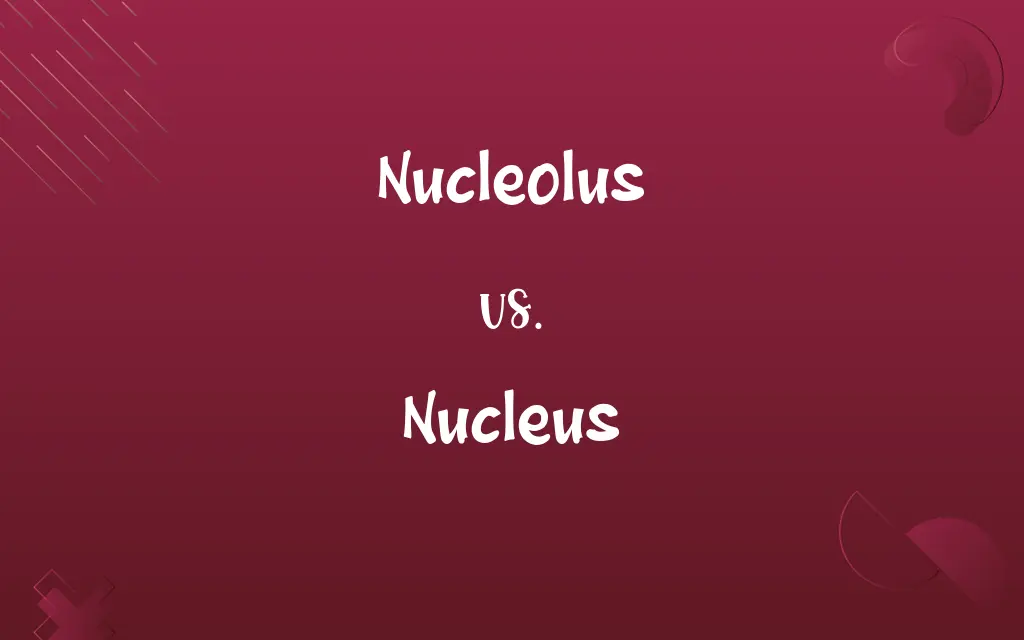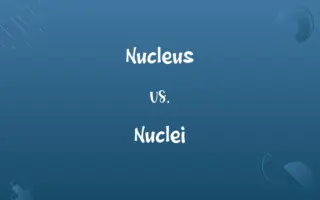Nucleolus vs. Nucleus: Know the Difference

By Shumaila Saeed || Published on January 12, 2024
The nucleolus is a dense region within the nucleus (the central part of a cell containing genetic material) specifically involved in ribosome synthesis.

Key Differences
The nucleolus is a distinct, dense, non-membrane bound structure located within the nucleus, the central organelle in a eukaryotic cell containing the cell's genetic material. While the nucleus houses DNA and controls cell activities, the nucleolus is primarily involved in the production of ribosomes.
Shumaila Saeed
Jan 12, 2024
In terms of function, the nucleus serves as the control center of the cell, regulating gene expression and maintaining DNA integrity. The nucleolus, conversely, is where ribosomal RNA (rRNA) is transcribed and ribosome assembly begins, playing a key role in protein synthesis.
Shumaila Saeed
Jan 12, 2024
Structurally, the nucleus is surrounded by a double membrane called the nuclear envelope, which contains nuclear pores for transport. The nucleolus, however, lacks a membrane and is formed around specific chromosomal regions known as nucleolar organizing regions.
Shumaila Saeed
Jan 12, 2024
During cell division, the nucleus undergoes dramatic changes, with its envelope disintegrating during mitosis. The nucleolus disassembles at the beginning of cell division and reassembles in the daughter cells, indicating its dynamic nature.
Shumaila Saeed
Jan 12, 2024
The size and number of nucleoli can vary depending on the cell type and its metabolic activity, reflecting the demand for protein synthesis. The nucleus, being a constant feature in eukaryotic cells, maintains its general structure and function across different cell types.
Shumaila Saeed
Jan 12, 2024
ADVERTISEMENT
Comparison Chart
Role in Cell Division
Disassembles and reassembles
Envelope disintegrates and reforms
Shumaila Saeed
Jan 12, 2024
Variation
Size and number vary by cell activity
Consistent structure across cell types
Shumaila Saeed
Jan 12, 2024
ADVERTISEMENT
Nucleolus and Nucleus Definitions
Nucleolus
It dynamically changes size based on the cell's ribosome production needs.
In a rapidly dividing cell, the nucleolus is larger to meet increased protein demands.
Shumaila Saeed
Dec 17, 2023
Nucleus
It plays a key role in cell regulation, growth, and reproduction.
The nucleus directs cellular activities based on the information in its DNA.
Shumaila Saeed
Dec 17, 2023
Nucleolus
The nucleolus disassembles during cell division and reassembles afterward.
During mitosis, the nucleolus temporarily disappears and then reforms in daughter cells.
Shumaila Saeed
Dec 17, 2023
Nucleus
The nucleus is the central organelle in eukaryotic cells, containing genetic material.
The nucleus controls cell functions through gene expression regulation.
Shumaila Saeed
Dec 17, 2023
Nucleolus
The nucleolus is a region within the nucleus dedicated to ribosome production.
The prominent nucleolus in a growing cell indicates active protein synthesis.
Shumaila Saeed
Dec 17, 2023
ADVERTISEMENT
Nucleus
The nucleus undergoes changes during cell division, including envelope breakdown.
In mitosis, the nuclear envelope disintegrates, allowing chromosome separation.
Shumaila Saeed
Dec 17, 2023
Nucleolus
It is the site for transcription of ribosomal RNA (rRNA) in the cell.
RRNA genes within the nucleolus are transcribed to initiate ribosome assembly.
Shumaila Saeed
Dec 17, 2023
Nucleus
A central or essential part around which other parts are gathered or grouped; a core
The nucleus of a city.
Shumaila Saeed
Dec 13, 2023
Nucleolus
The nucleolus is non-membrane bound, forming around nucleolar organizing regions.
In a cell nucleus, chromosomal regions form the nucleolus by clustering together.
Shumaila Saeed
Dec 17, 2023
Nucleus
Something regarded as a basis for future development and growth; a kernel
A few paintings that formed the nucleus of a great art collection.
Shumaila Saeed
Dec 13, 2023
Nucleolus
A small body in the nucleus of a cell that contains protein and RNA and is the site for the synthesis of ribosomal RNA and for the formation of ribosomal subunits.
Shumaila Saeed
Dec 13, 2023
Nucleus
(Biology) A membrane-bound organelle within a eukaryotic cell that contains most of the cell's genetic material. DNA transcription takes place in the nucleus.
Shumaila Saeed
Dec 13, 2023
Nucleolus
(cytology) A conspicuous, rounded body within the nucleus of a cell.
Shumaila Saeed
Dec 13, 2023
Nucleus
(Anatomy) A group of specialized nerve cells or a localized mass of gray matter in the brain or spinal cord.
Shumaila Saeed
Dec 13, 2023
Nucleus
(Physics) The positively charged central region of an atom, composed of protons and neutrons, about which negatively charged electrons orbit. Extremely small and dense, the nucleus contains almost all of the mass of an atom.
Shumaila Saeed
Dec 13, 2023
Nucleolus
A small rounded body contained in the nucleus of a cell or a protozoan.
Shumaila Saeed
Dec 13, 2023
Nucleus
(Chemistry) A group of atoms bound in a structure, such as a benzene ring, that is resistant to alteration in chemical reactions.
Shumaila Saeed
Dec 13, 2023
Nucleolus
A small round body of protein in a cell nucleus; nucleoli contain RNA and are involved in protein synthesis
Shumaila Saeed
Dec 13, 2023
Nucleus
The solid part of a comet, composed of ice and smaller amounts of dust and rock.
Shumaila Saeed
Dec 13, 2023
Nucleus
(Meteorology) A particle on which water vapor molecules accumulate in free air to form a droplet or ice crystal.
Shumaila Saeed
Dec 13, 2023
Nucleus
(Linguistics) The part of a syllable having the greatest sonority. In the word middlemost (mĭdl-mōst′) the nuclei of the three syllables are (ĭ), (l), and (ō); in the Czech word krk ("neck"), the nucleus is (r).
Shumaila Saeed
Dec 13, 2023
Nucleus
The core, central part of something, around which other elements are assembled.
Shumaila Saeed
Dec 13, 2023
Nucleus
An initial part or version that will receive additions.
This collection will form the nucleus of a new library.
Shumaila Saeed
Dec 13, 2023
Nucleus
The massive, positively charged central part of an atom, made up of protons and neutrons. Category:en:Nuclear physics
Shumaila Saeed
Dec 13, 2023
Nucleus
(cytology) A large membrane-enclosed organelle found in eukaryotic cells which contains genetic material.
Shumaila Saeed
Dec 13, 2023
Nucleus
(neuroanatomy) A ganglion, cluster of many neuronal bodies where synapsing occurs.
Shumaila Saeed
Dec 13, 2023
Nucleus
A kernel; hence, a central mass or point about which matter is gathered, or to which accretion is made; the central or material portion; - used both literally and figuratively.
It must contain within itself a nucleus of truth.
Shumaila Saeed
Dec 13, 2023
Nucleus
A body, usually spheroidal, in a eukaryotic cell, distinguished from the surrounding protoplasm by a difference in refrangibility and in behavior towards chemical reagents, which contains the chromosomal genetic material, including the chromosomal DNA. It is more or less protoplasmic, and consists of a clear fluid (achromatin) through which extends a network of fibers (chromatin) in which may be suspended a second rounded body, the nucleolus (see Nucleoplasm). See Cell division, under Division.
Shumaila Saeed
Dec 13, 2023
Nucleus
A part of the cell containing DNA and RNA and responsible for growth and reproduction
Shumaila Saeed
Dec 13, 2023
Nucleus
A small group of indispensable persons or things;
Five periodicals make up the core of their publishing program
Shumaila Saeed
Dec 13, 2023
Nucleus
(astronomy) the center of the head of a comet; consists of small solid particles of ice and frozen gas that vaporizes on approaching the sun to form the coma and tail
Shumaila Saeed
Dec 13, 2023
Nucleus
Any histologically identifiable mass of neural cell bodies in the brain or spinal cord
Shumaila Saeed
Dec 13, 2023
Nucleus
It is surrounded by a nuclear envelope with pores for molecular transport.
The nuclear envelope's pores allow RNA and proteins to move in and out of the nucleus.
Shumaila Saeed
Dec 17, 2023
Nucleus
The nucleus houses DNA and is the site of DNA replication and transcription.
Genetic information in the nucleus is transcribed into RNA before protein synthesis.
Shumaila Saeed
Dec 17, 2023
Repeatedly Asked Queries
How does the nucleolus function?
It produces ribosomal RNA and initiates ribosome assembly.
Shumaila Saeed
Jan 12, 2024
Does the nucleus change during cell division?
Yes, its envelope breaks down and reforms afterward.
Shumaila Saeed
Jan 12, 2024
Is the nucleolus a separate organelle?
No, it's a region within the nucleus without a membrane.
Shumaila Saeed
Jan 12, 2024
Is the nucleolus involved in genetic storage?
No, it's involved in ribosome production, not genetic storage.
Shumaila Saeed
Jan 12, 2024
What is the nucleolus?
A region within the cell nucleus involved in ribosome synthesis.
Shumaila Saeed
Jan 12, 2024
What is the nucleus?
The central organelle in eukaryotic cells containing genetic material.
Shumaila Saeed
Jan 12, 2024
Does the nucleus have a membrane?
Yes, it's surrounded by a double-layered nuclear envelope.
Shumaila Saeed
Jan 12, 2024
What are the primary functions of the nucleus?
Storing DNA, regulating gene expression, and controlling cellular activities.
Shumaila Saeed
Jan 12, 2024
Can the nucleolus be seen under a microscope?
Yes, it's visible as a dense area within the nucleus.
Shumaila Saeed
Jan 12, 2024
What happens to the nucleolus during cell division?
It disassembles and reassembles in the daughter cells.
Shumaila Saeed
Jan 12, 2024
How does the nucleus interact with other organelles?
Through molecular signals and transport via its pores.
Shumaila Saeed
Jan 12, 2024
How do substances enter and leave the nucleus?
Through nuclear pores in the nuclear envelope.
Shumaila Saeed
Jan 12, 2024
What is the significance of the nucleolus in cell division?
It ensures that new cells have the machinery for protein synthesis.
Shumaila Saeed
Jan 12, 2024
Can the number of nucleoli in a cell change?
Yes, it can vary based on the cell's stage and activity.
Shumaila Saeed
Jan 12, 2024
What role does the nucleus play in inheritance?
It houses DNA, which is passed on during reproduction.
Shumaila Saeed
Jan 12, 2024
Are there multiple nucleoli in one nucleus?
Yes, some cells have multiple nucleoli.
Shumaila Saeed
Jan 12, 2024
What is the relationship between the nucleolus and protein synthesis?
The nucleolus produces rRNA, essential for ribosome and protein synthesis.
Shumaila Saeed
Jan 12, 2024
What determines the size of the nucleolus?
The cell's ribosomal production and protein synthesis needs.
Shumaila Saeed
Jan 12, 2024
Does the nucleus contain RNA?
Yes, in the form of messenger RNA, transfer RNA, and ribosomal RNA.
Shumaila Saeed
Jan 12, 2024
How does the nucleus affect cellular metabolism?
It controls metabolic activities through gene regulation.
Shumaila Saeed
Jan 12, 2024
Share this page
Link for your blog / website
HTML
Link to share via messenger
About Author
Written by
Shumaila SaeedShumaila Saeed, an expert content creator with 6 years of experience, specializes in distilling complex topics into easily digestible comparisons, shining a light on the nuances that both inform and educate readers with clarity and accuracy.





































































